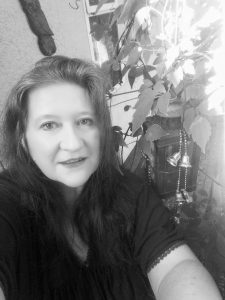MAKING THE DEAD LIVE AGAIN
MAKING THE DEAD LIVE AGAIN
By J.P. Reedman
 When I was a little girl growing up in Canada, Ancient Egypt meant more to me than dolls. Cleopatra was my hero and at age six, I wrote my first historical fiction story about her. At that young age, I also loved to wander through graveyards, looking at the headstones and trying to envision the lives of those who had gone before. My mother, with a great dollop of Irish superstition, was not impressed by my interest…but she didn’t stop me either.
When I was a little girl growing up in Canada, Ancient Egypt meant more to me than dolls. Cleopatra was my hero and at age six, I wrote my first historical fiction story about her. At that young age, I also loved to wander through graveyards, looking at the headstones and trying to envision the lives of those who had gone before. My mother, with a great dollop of Irish superstition, was not impressed by my interest…but she didn’t stop me either.
My sister, who was 15 years my senior, said ‘Maybe she’ll become an archaeologist or historian one day’ and read to me an autobiographical account of a young girl who travelled across Europe stopping in places such as Rome, Florence, Pompeii with her archaeologist parents, until she finally reached the shadow of the Egyptian pyramids… I never forgot that girl’s journey.
Later, as a young adult, I decided to take Anthropology as a subject in further education. Again, my mother was not impressed. “What are you going to do with that sort of thing?” she asked dismissively. “You’d be better off learning typing!” Despite the lack of support, I continued in my journey, however, learning Cultural and Women’s Anthropology. I was disappointed, however, that I could not take Forensic Anthropology, which was my main interest—back in the 80’s, at the local university, it was only for people taking Law! I began self-educating myself on that aspect instead.
At around the same time, I gained an interest in the prehistoric Stone Circles of the British Isles and Ireland. Sadly, I found many of the available books on these monuments disappointing—all about weights, measures and alignments. It almost felt as if the stones themselves had risen the from soil by the aid of ghosts—filmy, vague people, too distant from us to even envision.
I wanted to see those people and hear the drums beating around long-gone fires. I wanted the ancient dead to live again for me.
During the following years, I emigrated to the UK. I worked at Stonehenge for over a decade, and attended digs on Salisbury Plain, including at the Stones themselves, a Bronze Age burial mound full of later Anglo-Saxon burials, and a Mesolithic encampment where the burnt flint from the hunters’ fires was still red and cracked after 8000 years. I have sat in the archaeology lab cleaning a skeleton’s teeth with a tooth brush and wondering what her name was and how she lived 1600 years ago. (She was a little Saxon era lady aged about 60, a very good age for her time, and she had healed cut marks on her arms—defensive injuries!)
Things happen though, as things do, and due to medical issues, I became less able to do the things I used to, such as trudging around in freezing woodlands washing flints in icy waters. My other life-long love besides anthropology and history, was, of course, writing, and that now came to the fore.
My first book was THE STONEHENGE SAGA, which takes the Arthurian myths but transports them back into the early Bronze Age. It didn’t do too badly for a first novel, and attempts to show the warrior society that was arising in Britain at this time as well as some of the beliefs that seem to have been current (as much as we can tell.) I personally think the Irish legends some claim to be a ‘window’ on the ‘Celtic’ Iron Age are instead a window on this lost Bronze Age world.
From Stonehenge, I went forward in time to the Middle Ages with my series on Richard III (I, Richard Plantagenet) and forgotten medieval women (Medieval Babes). My novel MY FAIR LADY, on the ‘lost queen’ Eleanor of Provence, went to no 1 in its category on Amazon UK for several months, and a few years later, with the whole series selling well, I became a ‘full-time writer.’
I wrote both these series in first person to make them seem more personal and immediate…and what surprised me was that humour often emerged from the characters’ actions. I don’t believe that at any time of history people were as tomb-stone serious as some historical novels make them. People have, after all, have always used humour to cope in bleak situations—look at the last World War, look at the present…
Future plans include more medieval fiction, a high fantasy novel, and a return to the prehistoric—in a novel set in Mesolithic Britain, the time of dark-skinned, blue eyed Cheddar Man.
—
J.P. Reedman was born in Canada but has lived in the U.K. for the better part of 30 years.
Interests include folklore & anthropology, prehistoric archaeology (neolithic/bronze age Europe; ritual,burial & material culture), as well as The Wars of the Roses and the lesser-known and often forgotten women of the medieval era. J.P. loves travel and photography and can often be found poking around churches and ruined abbeys, or wandering around an archaeological site. Stonehenge, J.P.’s workplace for many years, is just over the nearby hill, while there’s a dead Queen lost in the nearby town, and burial mounds almost in the back garden–all fodder for exploration and writing!
Links: J.P. Reedman-Historical Fiction
Twitter: https://twitter.com/stonelord1
Facebook: https://www.facebook.com/Eleanor.TheLostQueen/
https://www.facebook.com/IRichardPlantagenet/
Category: On Writing

























